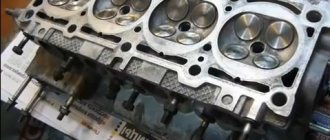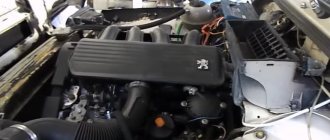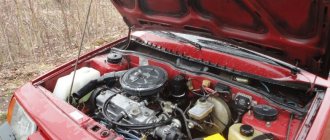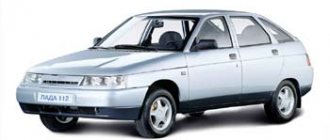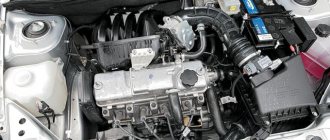By the end of the seventies of the twentieth century, the Toyota company managed to become famous for its products, the characteristics and quality of which, at that time, were not superior to any competitor on the market. By that time, the issue of improving the produced “M” version engines had become ripe.
So, in 79 of the twentieth century, the first engine marked 1G EU (later FE) rolled off the corporation’s assembly line, marking the beginning of a new series. The design of the first engine is simple, intended for installation on rear-wheel drive cars of class “E” and “E+”. Later, the base engine was repeatedly modified, a number of modifications were released, among which the 1G FE received the unspoken title of a reliable unit in the class. New technologies and ideas used on engines were considered innovative for that time, laid the foundation for modern engine construction and became the impetus for further improvement.
Toyota Altezza 1998 year:
Characteristics
| engine's type | petrol |
| Power | 135 - 170 hp (99 - 125 kW) |
| Torque | 195 Nm |
| Volume | 2.0 L (1988 cc) |
| Design | in-line |
| Fuel type | petrol |
| Fuel mixture | Intake manifold/Carburetor injection |
| Supply system | suction device |
| timing belt | DOHC |
| Timing drive | Toothed belt |
| Cooling type | liquid |
| Compression | 10 : 1 |
| Cylinder diameter | 75 mm |
| Piston stroke | 75 mm |
| Number of cylinders | 6 |
| Number of crankshaft bearings | 7 |
| Number of valves | 24 |
Maintenance schedule 1G FE 2.0 l/135 l. With.
The following intervals for replacing consumables are provided for the 1G FE engine:
- The timing belt must be replaced every 75,000 km, attachments after 50,000 km;
- It is recommended to adjust valve thermal clearances after 30,000 mileage;
- cleaning of the crankcase ventilation is provided every 2 years;
- The manufacturer recommends replacing the engine oil after 7,500 km along with the oil filter;
- the fuel filter should be replaced after 40,000 miles;
- The air filter must be replaced annually;
- after the coolant is packaged from the factory, the additives inside the antifreeze lose effectiveness after 40,000 km;
- the life of spark plugs in the DIS-4 engine system is 20,000 mileage;
- A burnout in the intake manifold is possible after 60,000 km.
Replacing the 1G FE belt
The first version (1988 - 1998) is considered more reliable, the second version (1998 - 2005) is economical, high-torque and responsive. In rear-wheel drive cars, with filter replacement, you will need 4.0 liters of SJ/SL class lubricant exactly, and in all-wheel drive cars, 4.2 liters of 5W20, 5W30, 10W30 oil.
In the DIS-6 ignition system (since 1998), spark plugs, all other things being equal, will last longer than 30 thousand km instead of 20.
Modifications
Based on the block, a number of modifications were produced, differing in power and design details:
- An early version of the 1G EU, produced until 1988, was used on Crown S110 sedans. The basic version had a compression ratio of 8.8 and developed a power of 125 hp. at 5400 rpm. In 1983, a forced version appeared with a power of 130 hp. This modification used a modified cylinder head and a piston group with a compression ratio of 9.2. In 1986, a version appeared, derated to 105 hp.
- By installing a 24-valve head, the developers created the 1G GEU model. The design of the part was created in collaboration with Yamaha; the intake manifold is equipped with flaps to adjust the geometry of the channels. The early version, produced in 1983-86, developed 160 hp. Subsequently, the unit was derated to 140 hp. The engines were installed on Chaser, Mark 2, Cresta sedans and a number of other cars.
- In 1986-88 a version of the previous engine was produced, equipped with 2 GT12 turbochargers. The engine received the designation 1G GTEU and was equipped with a piston group with a compression ratio reduced to 8.5. With an excess boost pressure of 0.5 bar, the unit developed a power of 185 hp.
- Simultaneously with the GTEU, the GZEU/GZE line of engines was introduced, distinguished by the use of mechanical compressors of the SC14 model. Depending on the time of production, the power is 160-170 hp. with a compression ratio of 8 and an excess boost pressure of up to 0.5 bar.
- In 1988, a 150-horsepower naturally aspirated version of the 1G GE appeared, distinguished by the use of an absolute air pressure sensor. At the same time, the 1G GTE was developed, equipped with a turbocharger with a boost pressure of up to 0.75 bar. The engine develops up to 210 hp. at 6200 rpm.
- The 1G FE modification was created for the basic configuration of the Mark 2 X90, Crown S140 and a number of other sedans. The engine uses an original 24-valve head, the power is 135 hp. In 1996, the engine was modernized, raising output to 140 hp.
- In 1998, a major modernization of the FE unit was carried out, which led to the creation of the latest production modification, FE Beams. The engine was equipped with a phase shifter for the exhaust camshaft, an electronic throttle unit and an improved intake manifold with variable channel lengths. The engines use a piston group that provides a compression ratio of 10. The engine remained on the assembly line until 2005.
Application
The first engines were intended for installation on cars with rear-wheel drive; the goal was to equip cars falling into the “E” and “E+” classes. After successful operation, it was decided to improve the unit for use on other cars. A total of seven generations of the engine have been identified; the list of applications is given in the table below.
What cars was the engine installed on:
Toyota:
- Crown
- Mark 2
- Supra
- Altezza
- Chaser
- Cresta
- Soarer
Lexus:
- IS 200
Lexus IS 200 2005:
Design Features
The 1GR inline 6-cylinder engine is built on a cylinder block made of gray cast iron. The use of such material made it possible to do without liners; the working surface of the cylinders is the processed metal of the block. Early versions have a 12-valve aluminum cylinder head with 1 camshaft. Later, internal combustion engines began to use a part with 24 valves and 2 shafts to drive the intake and exhaust valves, respectively.
On an early engine with 1 or 2 camshafts, the mechanism is driven by a belt. In 1988, a block head that was reduced in width was developed. The reduction in size was achieved by changing the drive circuit - only 1 shaft rotated from the belt. To drive the other, helical gears were used. Timing marks applied on the camshaft gears allow you to correctly set the valve timing. On all engine modifications except Beams, a broken belt does not damage the valves and pistons.
To supply fuel, distributed injection with an electronic controller (EFI system) is used. The cooling system fan is equipped with a special clutch that turns on when the temperature threshold is exceeded. The ignition system of early modifications includes 3 ignition coils connected to cylinders numbered 1-6, 2-5 and 3-4. Beams engines began to use individual coils located in spark plug wells.
The installed turbochargers are equipped with boost pressure regulators. Early engines used open-loop catalytic converters. Later, improved components began to be installed that ensure automatic adjustment of the mixture composition.
Description of the 1G FE motor device
Stock model
2jz engine: engine overview and technical specifications
The first development of the G series, designated 1G EU, was a cast iron block with 6 cylinders arranged in a row and a head with 12 valves. The engine power reached 125 hp/5400, and torque - 160 Nm/4400. Subsequent improvements to the design helped enhance the characteristics and improve the operation of the systems. However, the engine displacement is 1988 cc. cm, cylinder size and piston stroke of 75 mm each remained unchanged for the entire line.
When developing the Toyota 1G FE, the plant was faced with the task of creating a compact, modern engine to replace the 1G EU. To do this, they used a narrow cylinder head, previously designed by Yamaha engineers, into which 24 valves fit: 2 inlets and 2 outlets per cylinder. The cylinder block was left cast iron.
The gas distribution mechanism was built according to the DOHC scheme with two camshafts. The intake shaft was driven by a toothed belt, the exhaust shaft by a Twincam gear. To adjust the thermal gap, pushers with adjusting washers were used. The timing belt also drove the water pump and was tensioned using rollers.
The 1G FE engine was controlled by an ECU. The injection injection system was equipped with a MAP sensor. The ignition system worked from a distributor, which received high voltage from a coil. The first model of the unit did not receive complex electronic devices.
Modernization
In 1996, a restyled version 1G FE was released. Engineers updated the control system and modified the injectors. As a result, it was possible to increase the engine power by 5 hp. With. The real update began in 1998, when it was necessary to create an uprated engine for the Altezza based on the existing stock.
As a result of the modernization of the 1G FE internal combustion engine with the BEAMS prefix, it turned into an independent unit that has little in common with the stock version. The design of the head, connecting rod and piston group, and injectors have changed. Now there were no grooves on the piston heads. To adjust the gaps, pushers with replaceable cups were installed.
- The intake system was equipped with a VVT-i variable valve timing system. Now, at 6000 rpm, the standard camshaft cam was replaced by a cam with a different profile, which made it possible to increase traction for confident acceleration;
- the throttle valve was replaced with electronic ETCS;
- the intake manifold has a variable geometry thanks to the installation of an ACIS electro-pneumatic valve;
- Contact ignition was replaced with DIS6 - “distributorless ignition system.” Now each cylinder had its own coil, which increased the accuracy and reliability of the system.
BEAMS has become more powerful, more economical and more environmentally friendly than its predecessor. The compression ratio was increased to 10 to 1. Environmental standards increased from Euro-2 to Euro-3.
Advantages and disadvantages
The advantages of power units include:
- reliability and durability of the structure with timely maintenance;
- low noise level, no vibration during operation;
- simple design (versions of the 1G FE motor without a phase shifter);
- good power and traction parameters (only for Beams modification).
The disadvantages are:
- the lubrication system requires high quality oil;
- cutting off timing belt teeth at low temperatures;
- leakage of the frontal oil pump oil pump, which is driven by the timing belt;
- defects in oil pressure sensors;
- destruction of ignition system elements due to the age of engines;
- Dirt deposits in hydraulic compensators (on the Beams version);
- bending of valves when the belt breaks and low life of ignition coils (typical for the Beams modification).
Improved engine
August 1998 is notable for the fact that the 1G-FE engine has undergone major changes. From this moment on, the unit is called the 1G FE engine with the prefix BEAMS (Breakthrough Engine with Advanced Mechanism System), literally translated as “Breakthrough engine with an advanced mechanism system.” The first car to experience the modifications was the Toyota Altezza.
The 1G FE BEAMS installation has an engine layout similar to that used on the 1G FE engine, however, the unit has a complex core head filling, a new group of cylinders and pistons, as well as an improved crankshaft. The designers' task is to achieve an increase in power without changing the engine configuration. Therefore, the unit is equipped with sophisticated electronics: an automatic phase change system (VVT-i) and electronic throttle control (ETCS) are installed. The distributor was replaced by non-contact electronic ignition (DIS-6) with an individual coil for each cylinder. A mechanism is used that controls the geometry of the intake manifold (ACIS). The crankshaft speed and compression ratio are increased.
Toyota 1G FE BEAMS engine:
- Engine 1G FE BEAMS characteristics:
- Release period: 1998 – 2005;
- Volumetric displacement chambers: 6 pieces, arranged in a row;
- Engine capacity: 2 liters;
- Compression ratio: 10:1;
- Valves: four per cylinder, total - 24 pieces;
- Frame head: DOHC, belt drive, VVTi;
- Power: 160 horses, 6200 rpm;
- Fuel supply: injector, distributed injection (EFI);
- Ignition: coil for each cylinder (DIS-6);
- Fuel: gasoline AI-95;
- Resource 300,000 kilometers.
Important! The 1G-FE and 1G-FE BEAMS powerplants are structurally different mechanisms. Interchangeability of parts and mechanisms of products is not possible.
The ideas used improved the performance of the motor. However, modernization also had negative consequences. Thus, when servicing the engine, attention had to be paid to automatic phase changes, which incurs additional costs. In addition, a break in the gas distribution mechanism belt was now accompanied by a breakdown of the valves.
Malfunctions and repairs
Common defects in 1G generation motors:
- Increased oil consumption indicates that the piston rings are stuck. The phenomenon is considered normal taking into account the service life of the motors. In some cases, owners manage to restore performance by adding special additives. If oil consumption does not decrease, then a major overhaul or replacement of the engine with a contract unit with obviously low mileage is required.
- On the Toyota 1G FE modification, problems arise with the pressure sensor in the lubrication system. The repair consists of checking the oil pressure with a test pressure gauge and replacing the damaged element. It is recommended to check the condition of the sensor wiring. The lubrication system itself is sealed; a leak occurs around the sensor body; after installing a new part, the defect disappears.
- Floating idle speed is the result of a broken or clogged valve or throttle assembly. On later engines, the electric damper drive fails. To restore functionality, parts must be washed and worn elements replaced. When assembling, you must be careful, as there is a risk of incorrect installation of parts.
- The appearance of a large amount of oil in the compressed air supply channels. The defect occurs due to natural wear and tear of the compressor, which has a service life of 100-120 thousand km. Repair consists of replacing a failed unit.
Tuning
The engine design is not suitable for modifications. The only version suitable for tuning is the GTE series engine. A controller is installed on the unit, allowing the boost pressure to be increased to 1.1-1.2 bar. To cool the compressed air, a front radiator is used, mounted in front of the heat exchanger of the cooling system. Increasing the boost requires the use of a more efficient fuel pump and injectors; it also requires replacing the injection control unit with a modernized one.
The maximum power of the modified engines is 300 hp. while preserving the resource and the possibility of everyday use of the car. Further refinement involves the abandonment of 2 compressors in favor of 1 with increased productivity. To ensure performance, it is necessary to install a new piston group, which will reduce the compression ratio. The disadvantage of this modification is the high labor intensity and cost.
- Engine disassembly
- Acceleration 0-100 km/h (Toyota Mark II)
- Cold start
First generation
For eight years, its design remained unchanged. However, the release and restyling of new versions of cars in 1996 forced the Japanese company to modernize body elements, as well as the engine, to obtain higher power parameters. As a result of this modernization, power and torque increased by 5 horsepower and rpm, respectively. The design changes were not significant.
